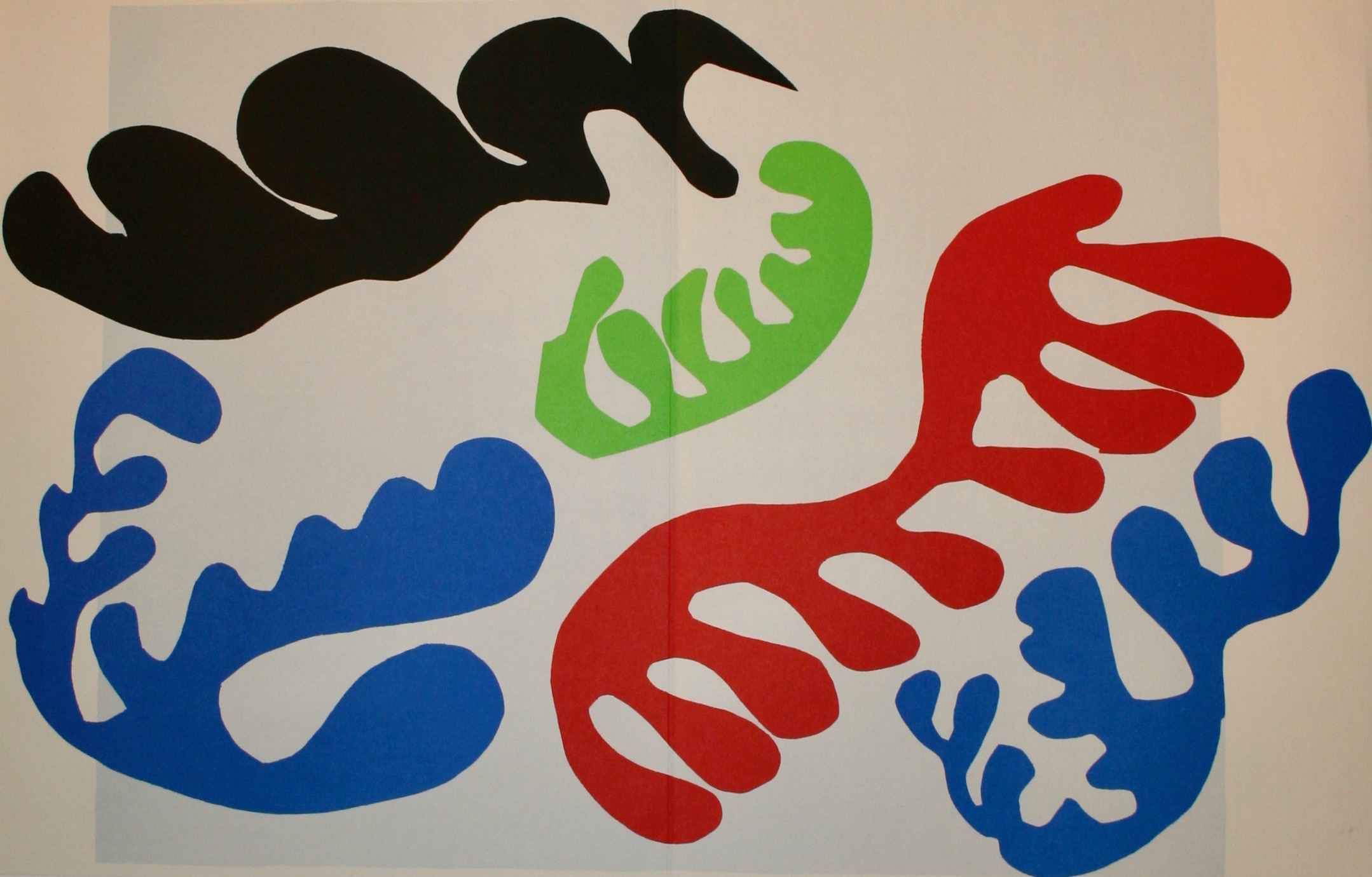

Title: Lagoon 1944 (Jazz) Henri Matisse Original Pochoir Print
Shipping: $29.00
Artist:
Period: N/A
History: N/A
Origin: Central Europe > France
Condition: N/A
Item Date: N/A
Item ID: 68
Le Lagon III Lagoon 1944 (Jazz) Henri Matisse, *(Original Pochoir Print) / Edition of 100, the so-called portfolio edition, and 20 hours commerce copies. Title: "Lagoon 1944" Medium: Pochoir (A Pochoir Print of a Paper Cut-Out from the Cheerful Book called Jazz, Published in 1947) unsigned Signed / Henri Matisse France 31 Dec 1869 - 03 Nov 1954. Original Pochoir printing, published in 1947. The Lagoon, plate XVIII from the illustrated book “Jazz, 1947”. Jazz was produced as an edition of 250 books, with the pages folded in half. Print of a Paper Cut-Out from the Cheerful Book called Jazz. Size *Approx: 23 1/2" x 15 1/3” Measured from edge to edge of the paper. Henri Matisse’s illustrated book Jazz (1947) is one of the most famous graphic works and arguably one of the best-loved artworks of the 20th century. In Matisse’s first major ‘cut-out’ project, realism and abstraction are finally reconciled at the end of a life-long tension. With the cut-out technique, Matisse felt he had finally solved the problems of form and space, outline and color. ‘It is not a beginning, it is an endpoint’, the artist stated. Jazz comprises a set of 20 vivid color stencils and over 70 pages of Matisse’s calligraphic writing. Jazz was pivotal in Matisse’s transition from oil painting to the cut-out collages that dominated the last decade of his life. To create these works, Matisse cut forms out of large sheets of paper previously painted with gouache by his assistants. The cut-outs were then assembled on the wall of Matisse’s studio, under his direction. The book’s title evokes the idea of a musical structure of rhythm and repetition, expressed through the handwritten text, which is broken by the explosive improvisations of the color plates. Matisse’s subjects are taken largely from the circus, mythology, and memories of his travels. They represent either isolated figures or paired forms that suggest a dialogue between artist and model. Despite the vivid colors and folkloric themes, few of the plates are actually cheerful. Several are among Matisse’s most ominous images.
The writing of Jazz was very important for Matisse and though the pictures were mostly finished by 1944, he continued to work on the text until shortly before the book was published in September 1947. While the text gives the impression of great spontaneity, it was written out four or five times until Matisse was satisfied with the manner of expression and size of handwriting. Matisse stated that his manuscript pages represent merely a visual accompaniment to the plates and ‘their role [was] thus purely spectacular’. Despite Matisse’s claim, the text and plates are actually subtly and consciously related. The underlying themes of art and artifice find many parallels in the text. Jazz represents one of Matisse’s most interesting statements about his artistic development and the act of creation, which he believed results from the synthesis of instinct and intellect guided by discipline.
Link: https://en.wikipedia.org/wiki/Jazz_(Henri_Matisse)
Henri Matisse’s Jazz is a limited–edition art book containing prints of colorful cut–paper collages, accompanied by the artist's written thoughts. It was first issued on September 30, 1947, by art publisher Tériade. The portfolio, characterized by vibrant colors, poetic texts, and circus and theater themes, marks Matisse's transition to a new form of medium.
Diagnosed with abdominal cancer in 1941, Matisse underwent surgery that left him chair– and bedbound. Limited in mobility, he could no longer paint or sculpt. Instead, he cut forms from colored paper that he arranged as collages, and decoupage which became known as the “cut–outs”.
That same year, at the age of 74, Matisse began Jazz. His assistants helped prepare the collages for printing, using a stencil process known as pochoir in French. He worked on the series for two years, utilizing this new method that linked drawing and color—two important elements in Matisse's work.
The designs were initially intended as covers for Verve, a French art magazine published by Tériade. In 1947, Tériade issued the compositions in an artist's portfolio. The book included 20 color prints, each about 16 by 26 inches (41 by 66 cm), as well as Matisse's handwritten notes expressing his thoughts throughout the process. Tériade gave it the title Jazz, which Matisse liked because it suggested a connection between art and musical improvisation. Despite the low number of books printed, Jazz was well received.
The circus, the title originally suggested for the book, provided inspiration for the majority of the motifs concerning performing artists and balancing acts. “These images, with their lively and violent tones, derive from crystallizations of memories of circuses, folktales, and voyages,” Matisse explains in the accompanying text. The figure of the circus artist, usually depicted alone, is often seen as a metaphor for the artist himself.
The first prints illustrating the circus do not seem to have an immediate connection to the succeeding works. However, these compositions are viewed as metaphors of life. The overall themes in Jazz derive from biographical elements, such as Matisse's recollection of his travels to Tahiti in the three "Lagoon" sheets (XVII–XIX), as well as broader aspects including love (V, VI), death (X), and fate (XVI).